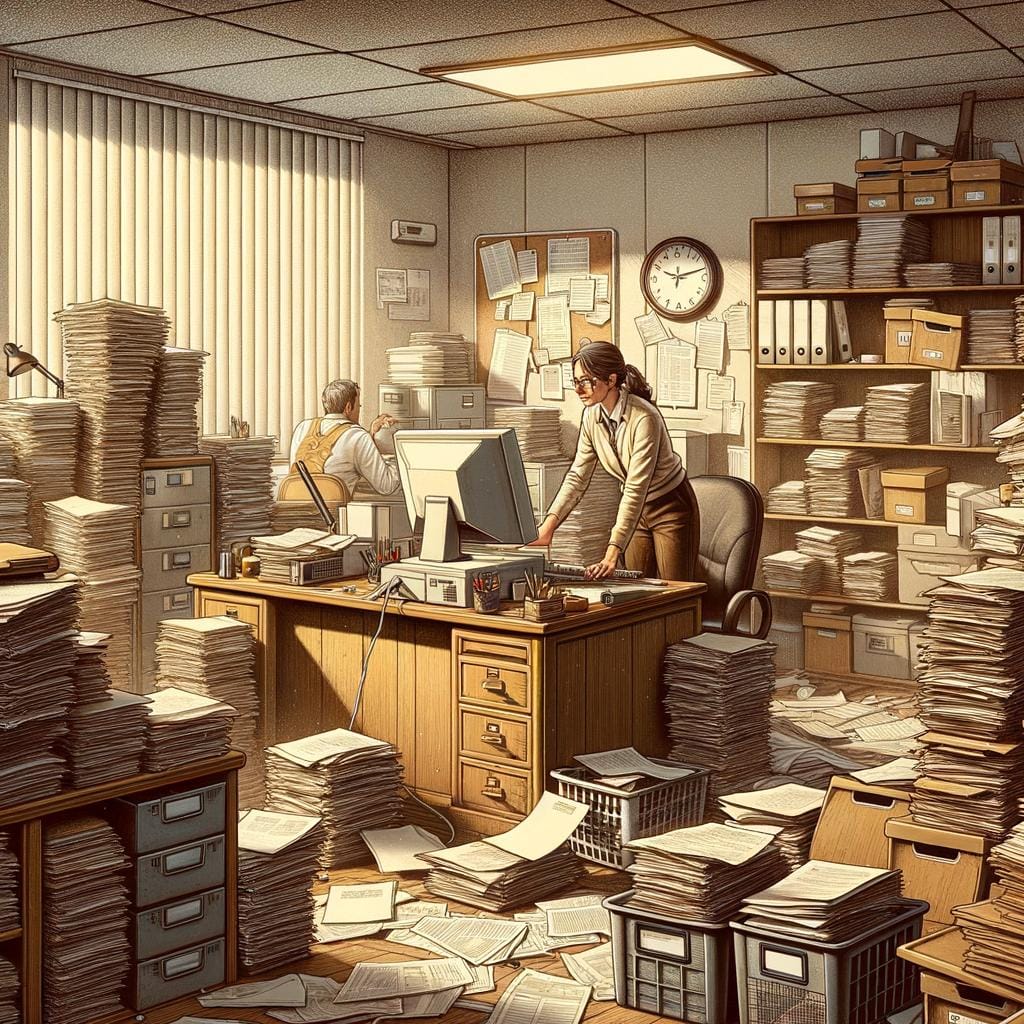Are you feeling overwhelmed by the chaotic mess in your office space? Managing office clutter is essential for maintaining a productive and efficient work environment. Clutter not only affects the physical space but also has a significant impact on productivity and morale among employees. Understanding the reasons why clutter builds up and the negative effects it can have is crucial for taking steps towards decluttering effectively.
There are several factors that contribute to the accumulation of office clutter, such as lack of organization systems, hoarding tendencies, or simply being too busy to prioritize tidying up. The end result can be decreased focus, increased stress, and lower overall morale within the workplace. Recognizing these consequences is key to realizing the importance of implementing strategies to declutter your workspace.
In this article, we will explore the detrimental effects of office clutter on productivity and employee well-being. We will also provide practical tips and organizational tools to help you effectively declutter your workspace.
By creating a system for maintaining a clutter-free office and incorporating minimalist design principles, you can transform your work environment into a more productive and enjoyable space. Let’s delve into the world of managing office clutter to improve success and well-being in your workplace.
Reasons Why Office Clutter Builds Up
Office clutter can build up in an office setting for a variety of reasons. Understanding the underlying causes can help individuals and organizations implement effective strategies to tackle and prevent clutter. Here are some common reasons why office clutter builds up:
- Procrastination: One of the main reasons office clutter accumulates is procrastination. Putting off organizing or tidying up can lead to a buildup of papers, files, and other items on desks and workspaces.
- Lack of storage solutions: Without adequate storage systems in place, it is easy for items to pile up on desks, floors, and other surfaces. Insufficient storage options can contribute to a cluttered office environment.
- Unwillingness to discard items: Some individuals may struggle with letting go of unnecessary or outdated items, leading to a buildup of clutter. The fear of needing something in the future or sentimental attachment to objects can hinder decluttering efforts.
Addressing these root causes can help individuals proactively manage office clutter before it becomes overwhelming. By recognizing the factors contributing to clutter accumulation, individuals can develop personalized decluttering strategies that are effective and sustainable over time. Taking proactive steps to address the reasons behind office clutter buildup can lead to a more organized and efficient workspace.
The Negative Effects of Office Clutter on Productivity and Morale
Office clutter can have a significant impact on productivity and morale in the workplace. When employees are surrounded by disorganized piles of paper, files, and miscellaneous items, it can create a sense of chaos and overwhelm. This can lead to decreased focus, concentration, and overall efficiency in completing tasks. Studies have shown that a cluttered workspace can contribute to increased stress levels, which in turn can affect employee morale and job satisfaction.
In addition to affecting productivity, office clutter can also hinder creativity and innovation. A cluttered environment can make it difficult for employees to think clearly and come up with new ideas. It can stifle creativity by creating a sense of mental blockage and hindering the flow of inspiration. By clearing out the physical clutter in the office, employees may find themselves feeling more invigorated and motivated to think outside the box.
To combat the negative effects of office clutter on productivity and morale, it is essential for organizations to prioritize regular decluttering activities. Encouraging employees to keep their workspaces clean and organized can go a long way in improving focus, motivation, and overall well-being in the workplace. Implementing storage solutions such as shelves, filing cabinets, and desk organizers can help create a more streamlined work environment that fosters productivity and creativity.
| Effects of Office Clutter | Impact |
|---|---|
| Decreased productivity | Employees may struggle to focus and complete tasks efficiently |
| Reduced morale | Clutter can contribute to increased stress levels and decreased job satisfaction |
| Stifled creativity | A cluttered environment can hinder innovative thinking and problem-solving skills |
Tips for Decluttering Your Workspace Effectively
Assessing Your Workspace
Before diving into decluttering your office space, it’s essential to take a step back and assess the current state of your workspace. Identify areas that accumulate the most clutter, whether it’s your desk, filing cabinets, or storage shelves. Take note of items that are essential for daily tasks and those that are simply taking up space. By understanding the root causes of clutter in your office, you can create a targeted plan for organization.
Establishing a Decluttering Routine
One effective way to manage office clutter is to establish a regular decluttering routine. Set aside dedicated time each day or week to tidy up your workspace. This can help prevent clutter from building up over time and maintain an organized environment. Consider implementing a “one-touch” rule where you handle each item only once – either by using it, storing it properly, or discarding it if no longer needed.
Utilizing Storage Solutions
Investing in proper storage solutions is key to decluttering your workspace effectively. Use storage bins, shelves, file organizers, or drawer dividers to keep items properly sorted and easily accessible. Labeling containers and folders can also help you quickly locate documents or supplies when needed. By maximizing vertical space and utilizing functional storage solutions, you can streamline your workflow and reduce unnecessary clutter in your office.
Organizational Tools and Systems to Manage Office Clutter
Organizational tools and systems play a crucial role in managing office clutter effectively. One of the most common organizational tools is the use of file cabinets, folders, and storage containers to keep documents and items neatly stored away. By categorizing and labeling these storage solutions, employees can easily locate what they need without adding to the clutter on their desks or in common areas.
In addition to physical tools, digital organizational systems are also essential for managing office clutter. Utilizing software applications for digital file management, task tracking, and project planning can help streamline workflows and reduce the need for excessive paper documents. Implementing cloud storage solutions can further assist in decluttering physical spaces by transferring important files to secure online platforms.
Furthermore, establishing daily routines such as clearing out unnecessary items at the end of each workday or designating specific times for organizing can significantly impact managing office clutter. Encouraging employees to adopt these habits not only promotes a cleaner workspace but also boosts productivity and overall morale in the office environment. By creating a culture of organization and efficiency, businesses can enjoy the benefits of a decluttered office that contributes to their success and well-being.
| Organizational Tools | Digital Systems |
|---|---|
| File Cabinets | Software Applications |
| Folders | Digital File Management |
| Storage Containers | Cloud Storage Solutions |
Creating a System for Maintaining a Clutter-Free Office
Establishing Daily Habits
One of the key aspects of maintaining a clutter-free office is to establish daily habits that contribute to organization and cleanliness. Make it a habit to tidy up your workspace at the end of each workday, putting away items, filing documents, and clearing off your desk.
Set aside some time each day to go through any new paperwork or items that have accumulated and decide whether they are needed or can be discarded. By consistently practicing these habits, you can prevent clutter from building up and maintain a clean environment.
Implementing Storage Solutions
Investing in storage solutions such as bins, shelves, cabinets, and organizers can help maximize space in your office and keep things organized. Designate specific areas for different categories of items, such as supplies, paperwork, electronics, and personal belongings. Label containers and shelves to make it easier to locate items when needed. By having designated places for everything in your office, you can reduce clutter and create a more efficient workspace.
Regularly Reviewing and Reevaluating
To ensure that your clutter-free system remains effective, it’s essential to regularly review and reevaluate your organization methods. Periodically go through your office space to identify any areas that are starting to accumulate clutter or could use improvement. Make adjustments to your storage systems as needed and reassess your workflow to streamline processes. By staying proactive in managing office clutter, you can maintain a clean and organized workspace for increased productivity and well-being.
Incorporating Minimalist Design Principles for a Clean Workspace
An office environment that is cluttered can lead to decreased productivity, increased stress levels, and overall dissatisfaction among employees. Incorporating minimalist design principles in the workspace can help create a clean and organized environment that enhances focus, efficiency, and well-being.
To incorporate minimalist design principles for a clean workspace, consider the following tips:
- Keep only essential items on your desk to avoid visual clutter.
- Choose furniture with clean lines and neutral colors to create a sense of simplicity.
- Use storage solutions such as shelves, cabinets, and organizers to keep items out of sight but easily accessible.
By embracing minimalism in your office design, you can create a space that promotes clarity of thought and productivity. A clutter-free environment allows for better concentration, reduces distractions, and fosters a sense of calmness in the workplace.
Implementing minimalist design principles not only improves the physical appearance of an office but also has a positive impact on the mental well-being of employees. By managing office clutter through intentional design choices, organizations can create a space that supports success and overall happiness among their team members.
Case Studies
Implementing office decluttering strategies can have a significant impact on productivity, efficiency, and overall well-being in the workplace. Let’s take a look at some success stories of organizations that have successfully managed their office clutter and seen positive results.
One notable case study comes from a marketing agency that struggled with a disorganized workspace due to piles of paper, files scattered around, and overflowing storage cabinets. Recognizing the need for change, the company implemented a comprehensive decluttering plan that involved decluttering sessions for employees, setting up designated storage areas for different types of documents, and implementing digital filing systems.
As a result, employees reported feeling less stressed, more focused, and able to locate important information quickly, ultimately leading to improved work efficiency and client satisfaction.
Another success story comes from a tech startup that adopted minimalist design principles to reduce office clutter. By embracing the concept of “less is more,” the company eliminated unnecessary furniture, streamlined workstations, and implemented a paperless policy. This not only created a visually appealing workspace but also improved collaboration among team members and boosted creativity. Employees found it easier to concentrate on their tasks without distractions from cluttered desks or overcrowded shelves.
Conclusion
In conclusion, it is evident that managing office clutter is crucial for maintaining a productive and uplifting work environment. The impact of office clutter on productivity and morale cannot be overstated, as it can lead to distractions, decreased efficiency, and increased stress levels among employees. By understanding the reasons why office clutter builds up and recognizing the negative effects it can have on both individuals and organizations, it becomes clear that taking proactive measures to declutter workspaces is essential.
Implementing tips for decluttering your workspace effectively and utilizing organizational tools and systems can help in managing office clutter efficiently. Creating a system for maintaining a clutter-free office is also crucial to ensure long-term success in keeping workplaces organized and conducive to productivity. Incorporating minimalist design principles can further enhance the overall quality of work environments, creating clean and inspiring spaces that promote well-being among employees.
Ultimately, adopting strategies to declutter offices not only leads to improved productivity but also contributes to the overall success and well-being of individuals within the organization. Through case studies showcasing successful implementations of office decluttering strategies, it is evident that a clutter-free office fosters creativity, motivation, and overall satisfaction among employees. Therefore, investing time and effort into managing office clutter is key to creating a harmonious work environment where individuals can thrive and excel in their roles.
Frequently Asked Questions
How Do I Get Rid of Clutter in Office?
Getting rid of clutter in the office can be a daunting task, but it is essential for maintaining a productive work environment. Start by sorting through items and deciding what to keep, donate, or throw away. Create designated storage spaces for different categories of items to help maintain organization. Regularly assess and declutter to prevent accumulation of unnecessary items.
How Do You Declutter a Messy Office?
Decluttering a messy office requires a systematic approach to tackle the chaos. Begin by clearing out one area at a time, starting with the most cluttered or distracting space.
Sort through papers, supplies, and other items, deciding what is necessary and what can be discarded or relocated. Establish an organizational system that works for you to maintain order in the long run.
How Do You Start Decluttering When Overwhelmed?
When feeling overwhelmed by clutter, it’s important to start small and focus on one manageable task at a time. Set realistic goals for decluttering, such as dedicating 15 minutes each day to organizing a specific area.
Break down larger projects into smaller steps to make them more manageable and less intimidating. Celebrate small victories along the way to stay motivated and build momentum towards achieving your decluttering goals.

Hello, I’m April Denton, your go-to expert for all things home decluttering and organization. With over a decade of experience helping individuals transform their living spaces into serene, clutter-free sanctuaries, I am passionate about the life-changing benefits of decluttering. My journey into the world of organization began out of necessity, juggling a busy career and a bustling household. I quickly realized that a well-organized home was the key to a more balanced, stress-free life.





